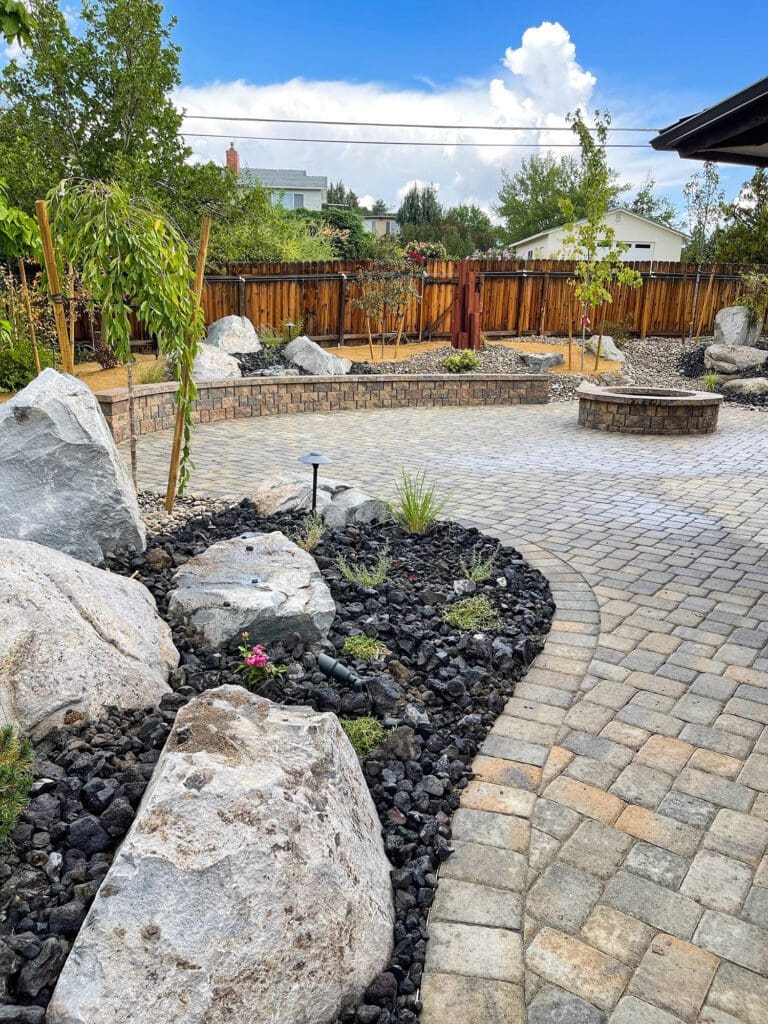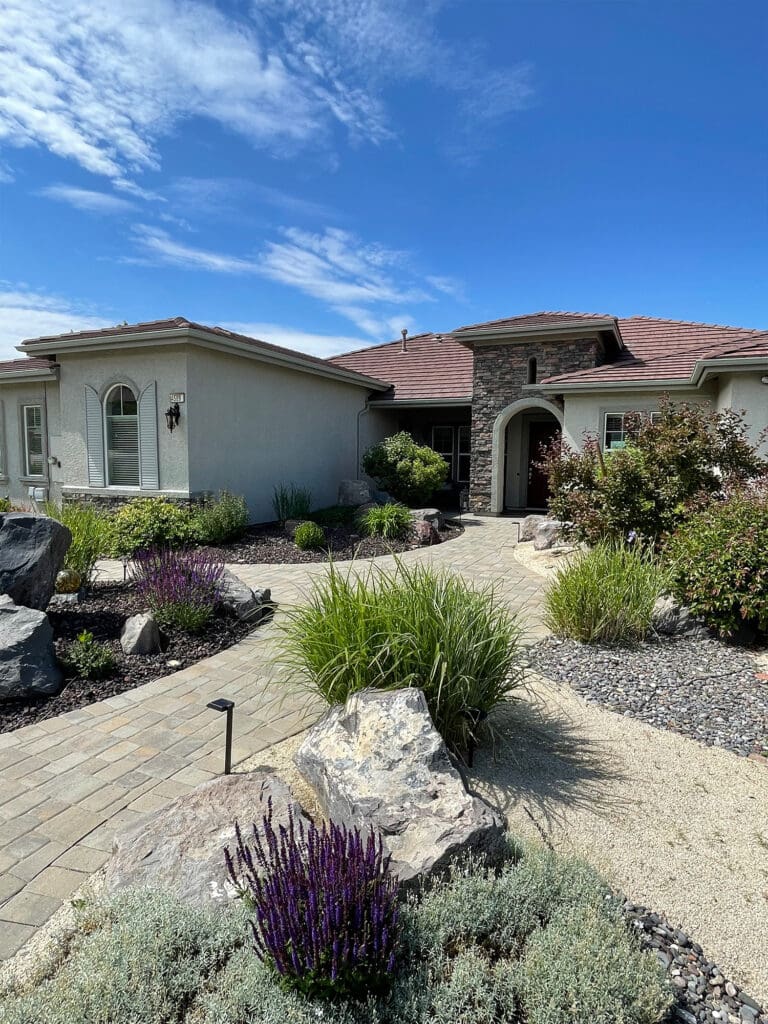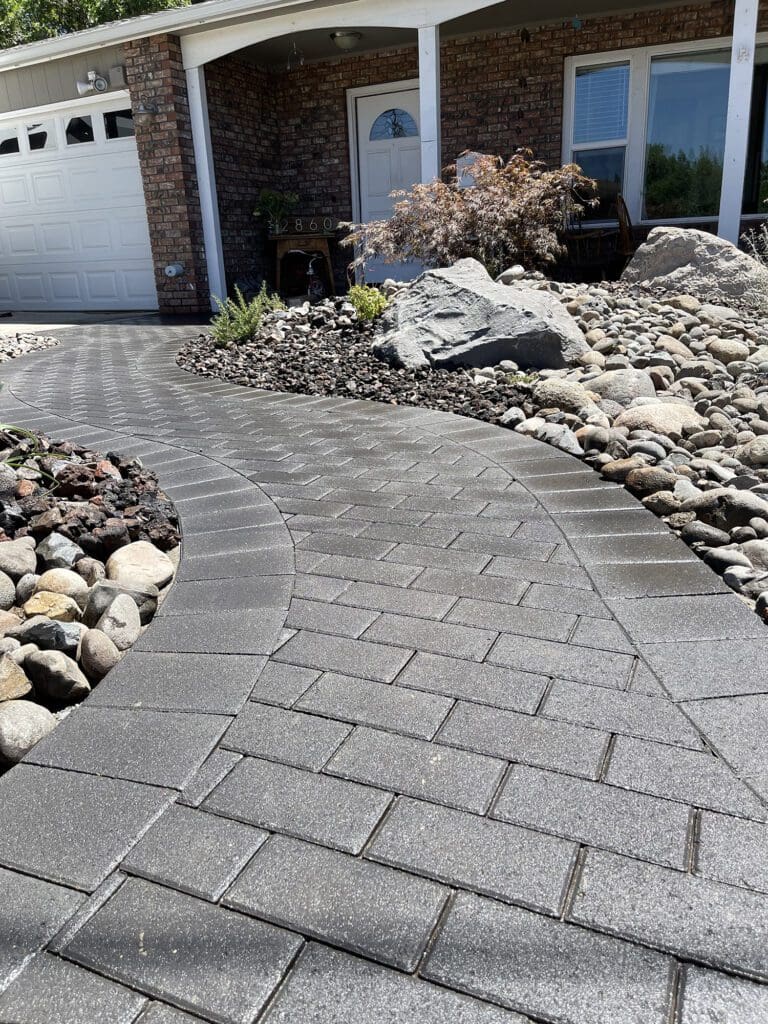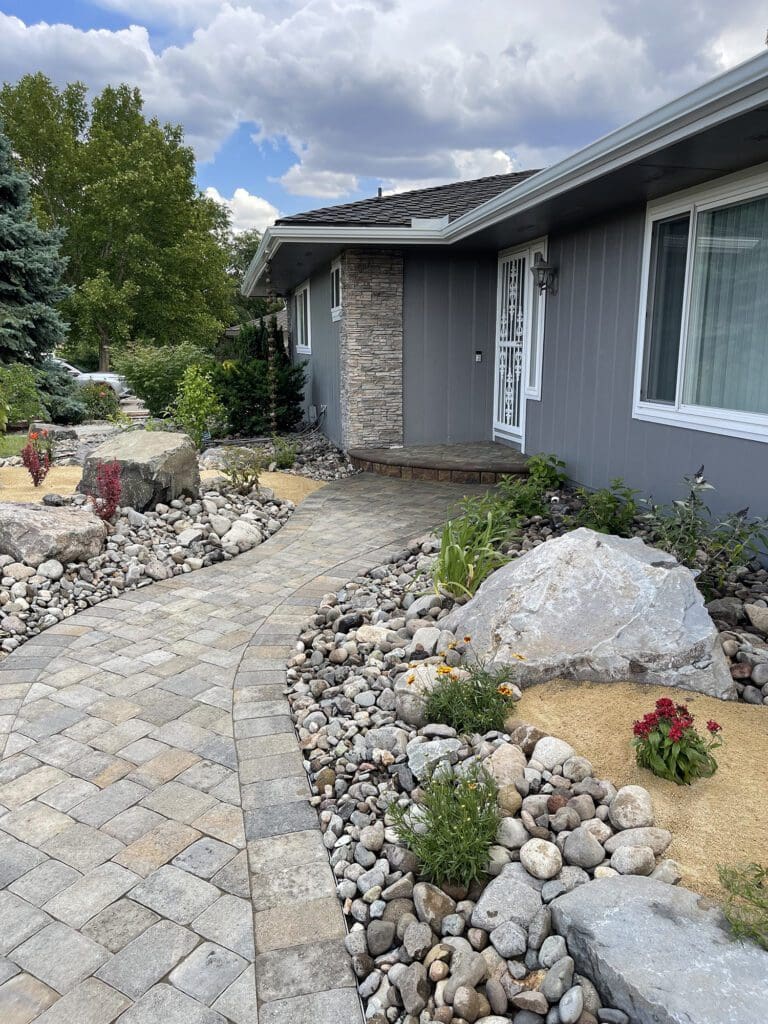As you prepare for fire season in Reno, it's crucial to take proactive measures to protect your landscaping and property. Creating defensible zones around your property is a key strategy to reduce the risk of wildfires spreading. This involves regular maintenance, choosing fire-resistant plants, and incorporating hardscaping to create safe pathways. By taking these steps, you can significantly reduce the threat of wildfires to your home and community. Regular updates to your landscaping will also ensure that your property remains safe and visually appealing throughout the year.
Regular Maintenance: A Key to Reducing Wildfire Risk in Landscape in Reno

Regular maintenance is essential to reduce damage to both your community and home during fire season. This includes removing dead or flammable vegetation, pruning trees, and ensuring that your yard is free from debris. By maintaining a clean and well-manicured yard, you reduce the continuous fuel bed that could otherwise spread fire quickly. Additionally, regular inspections can help identify potential fire hazards early, allowing you to address them before they become serious issues. Contacting a professional service can provide you with tailored advice and assistance to maintain your property effectively.
Proper maintenance also involves managing vegetation density and spacing. This can be achieved by thinning out dense areas of plants and trees, which helps prevent fire from spreading rapidly across your property. Furthermore, maintaining a consistent watering schedule ensures that plants remain healthy and less susceptible to ignition. Regularly inspecting your property for any signs of fire risk will also help you stay ahead of potential threats. By integrating these practices into your routine, you can help safeguard your property and contribute to a safer community.
Regular maintenance is not a one-time task; it requires ongoing effort to maintain effectiveness. As the seasons change, so do the needs of your landscaping. Adjusting your maintenance schedule accordingly will ensure that your property remains protected throughout the year. This might involve seasonal pruning, mulching, or other activities that help maintain fire resistance. By prioritizing regular maintenance, you not only protect your property but also play a role in reducing the overall fire risk in your community. Moreover, maintaining a well-kept property can enhance its aesthetic appeal and increase its value.
Creating a Fire Break: A Crucial Step in Reno
Creating a fire break is necessary when living in Reno, as it provides a critical barrier between your property and any approaching wildfires. This involves designing a fire-resistant buffer zone around your home, which can help stop or slow the spread of fire. Fire breaks often incorporate hardscaping elements like stone walls, patios, or gravel, which are less likely to burn than vegetation. Additionally, selecting fire-resistant plants for your landscaping can further enhance this buffer zone. By creating a fire break, you provide firefighters with a safer area to defend your home from an approaching fire.
A well-designed fire break should be tailored to the specific needs of your property. This might involve removing flammable vegetation and replacing it with fire-resistant alternatives. It's important to consider the layout of your property and ensure that the fire break is positioned effectively to maximize its protective benefits. Consulting with a professional can help you design a fire break that meets your property's unique requirements. By integrating a fire break into your landscaping, you significantly reduce the risk of wildfire damage to your property. This proactive approach not only protects your home but also contributes to a safer community environment.
Incorporating fire-resistant plants into your landscaping is another effective way to enhance your fire break. These plants are less likely to burn and can help slow the spread of fire. By choosing plants that are green, well-irrigated, and spaced appropriately, you can further reduce the risk of wildfires. It's also important to maintain these plants regularly to ensure they remain healthy and effective. By combining these strategies, you can create a robust fire break that protects your property during fire season. Additionally, maintaining a well-planned fire break can enhance the overall appearance of your landscaping.
Healthy and Hydrated Plants: Slowing Fire Spread
Healthy and hydrated plants burn slower, which is crucial in slowing the spread of wildfires. Proper irrigation systems, such as drip irrigation, can help keep your plants well-watered without wasting water. This not only enhances their fire resistance but also supports their overall health. By maintaining a consistent watering schedule, you ensure that your plants remain less susceptible to ignition. Regular inspections will also help identify any areas where plants may be struggling, allowing you to address these issues promptly.
Well-irrigated plants are more resistant to fire because they contain more moisture, making them less likely to burn quickly. This is particularly important in areas prone to wildfires, as it can provide valuable time for firefighters to respond effectively. Additionally, using plants that are known to be fire-resistant can further enhance this protective effect. While no plants are completely fireproof, choosing those that are less likely to burn can significantly reduce the risk of wildfire damage. By integrating these strategies into your landscaping, you can create a safer and more resilient environment.
Maintaining healthy and hydrated plants also involves ensuring they receive adequate nutrients and sunlight. This can be achieved through regular fertilization and pruning, which helps maintain plant health and appearance. By combining these practices with proper irrigation and fire-resistant plant selection, you can create a robust defense against wildfires. Moreover, maintaining healthy plants can enhance the aesthetic appeal of your property, making it both safer and more visually appealing. By prioritizing plant health, you contribute to a safer community environment.
Hardscaped Exit Routes: Ensuring Safety
Hardscaped exit routes are essential for ensuring safety during wildfires. These routes provide a clear path for evacuation and can help guide firefighters to your property. By incorporating materials like gravel, rock, or concrete into your landscaping, you create pathways that are less likely to catch fire. This not only enhances safety but also provides a clear visual indication of where to go in case of an emergency. Additionally, well-designed hardscaped routes can enhance the overall appearance of your property.
Hardscaped exit routes should be carefully planned to ensure they are safe and accessible. This involves considering the layout of your property and identifying the most direct and safest paths for evacuation. It's important to ensure that these routes are clear of debris and obstacles, which can pose a risk during emergency situations. By maintaining these routes regularly, you can provide a safe and reliable means of exit in case of a wildfire. This proactive approach not only protects your property but also enhances community safety.
Incorporating hardscaped exit routes into your landscaping can also provide additional benefits. These routes can help delineate different areas of your property, enhancing its visual appeal. Additionally, they can serve as a guide for firefighters, directing them to safe areas from which to defend your home. By integrating hardscaped exit routes into your overall landscaping strategy, you can create a safer and more resilient property environment. This approach not only protects your home but also contributes to a safer community.
Closing the Gap: Protecting Your Property with Comprehensive Strategies
By combining regular maintenance, fire breaks, healthy plants, and hardscaped exit routes, you can create a comprehensive strategy to protect your property from wildfires in Reno. Each of these elements plays a crucial role in reducing the risk of fire damage and enhancing overall safety. As you prepare for fire season, consider reaching out to a professional service to help you implement these strategies effectively. They can provide tailored advice and assistance to ensure your property remains protected and visually appealing throughout the year. By prioritizing these measures, you not only safeguard your home but also contribute to a safer community environment. Contact us today to schedule a consultation and get expert guidance tailored to your Reno home.
Reno homeowners are increasingly seeking innovative ways to enhance their outdoor spaces. As landscaping trends evolve, more emphasis is being placed on sustainability, functionality, and natural beauty. Whether the goal is to reduce water consumption, attract pollinators, or create a seamless transition between indoor and outdoor living, 2025 presents new opportunities for homeowners to rethink their landscapes.
Implementing these trends ensures a backyard that is both visually appealing and well-suited to Northern Nevada’s climate. By working with a professional landscaping team, homeowners can transform their outdoor spaces into beautiful, functional retreats.
Sustainability continues to be a top priority in landscaping design. With Reno’s dry climate, embracing drought-tolerant plants, rain gardens, and composting can significantly reduce water usage while maintaining a lush, green space.
Using native plants such as sagebrush, lupine, and rabbitbrush helps conserve water and supports local wildlife. Incorporating permeable hardscaping materials, such as gravel and decomposed granite, improves drainage and reduces runoff. Composting and mulching further enrich the soil, reducing the need for synthetic fertilizers. Homeowners looking for low-maintenance, environmentally conscious landscaping solutions are increasingly turning to these sustainable practices.

Backyards are no longer just for gardening; they are now extensions of the home. The demand for outdoor kitchens, fire pits, and multi-purpose seating areas continues to grow as homeowners seek to create functional outdoor living spaces.
A well-designed backyard can include defined areas for relaxation, dining, and entertainment. Features like built-in seating, pergolas for shade, and ambient lighting enhance usability while creating a comfortable and inviting atmosphere. These elements not only increase property value but also make outdoor spaces more enjoyable year-round.
Landscaping trends in 2025 emphasize the importance of planting native and pollinator-friendly species. Native plants naturally thrive in Reno’s climate, requiring minimal maintenance while providing food and habitat for bees, butterflies, and other beneficial insects.
Popular choices include milkweed, yarrow, and penstemon, which add vibrant color while supporting biodiversity. Grouping plants based on their water and sunlight needs ensures they grow efficiently with minimal upkeep. These selections help create a resilient, thriving landscape that contributes to the region’s ecosystem.
Water conservation remains a key concern for Reno homeowners, making smart irrigation systems a crucial investment. Upgrading to drip irrigation with automated timers helps reduce water waste by delivering moisture directly to plant roots.
Soil moisture sensors and weather-responsive irrigation controllers further optimize water usage, adjusting output based on real-time environmental conditions. These systems prevent overwatering and ensure that landscapes remain healthy while keeping water bills in check. Investing in modern irrigation technology is an effective way to maintain a green and efficient outdoor space.
Homeowners in Reno looking to embrace 2025’s top landscaping trends can benefit from professional guidance. Thoughtful design, expert installation, and proper maintenance ensure that outdoor spaces remain both beautiful and functional. By integrating sustainable gardening, outdoor living spaces, native plant selections, and smart irrigation, any backyard can be transformed into a thriving, low-maintenance retreat.
Those ready to enhance their landscapes can explore tailored solutions that fit their unique vision. Contact Little City Landscape today to schedule a consultation and start creating a backyard that blends aesthetics with long-term sustainability.
Pavers are a beautiful and durable addition to outdoor spaces, offering both functionality and aesthetic appeal. However, like any investment in your home, they require proper care to maintain their pristine condition over time. For homeowners who value design, quality, and long-term durability, understanding the basics of paver maintenance can help preserve the beauty and functionality of their outdoor areas. Little City Landscape, a trusted name in Reno for professional paver installation and maintenance, provides expert guidance on keeping your pavers looking new. Whether it’s a patio, walkway, or driveway, these practical tips ensure your outdoor spaces remain as stunning as the day they were installed.
Keeping pavers clean is one of the simplest ways to maintain their appearance and prevent long-term damage. Dirt, debris, and organic matter can accumulate on the surface over time, leading to discoloration or even weed growth between the joints.
Weed growth between pavers can be both unsightly and damaging over time. Applying polymeric sand during installation or maintenance creates hardened joints that inhibit weed growth while stabilizing the pavers. Regular inspections and prompt removal of any emerging weeds ensure they don’t take root or spread further.

Sealing pavers is an essential step in protecting them from weathering, staining, and wear caused by daily use or exposure to the elements. A high-quality sealer enhances the color and texture of the pavers while providing a protective barrier against moisture, oil spills, and UV rays.
For homeowners with a keen eye for design, choosing the right sealer—whether matte, semi-gloss, or high-gloss—can enhance the overall aesthetic of their outdoor space. Professional assistance ensures even application and long-lasting results that align with your vision.
Over time, environmental factors or regular use may cause minor issues such as shifting, cracking, or chipping in pavers. Addressing these problems promptly prevents them from escalating into more significant concerns that could compromise the integrity of your outdoor space.
Engaging professional contractors ensures repairs are performed with precision and care, preserving both the functionality and design of your paved areas.
Each season presents unique challenges for maintaining pavers, especially in Northern Nevada’s climate where temperature fluctuations and weather conditions can impact outdoor surfaces.
By adapting maintenance practices to seasonal changes, homeowners can protect their investment year-round while ensuring their outdoor spaces remain attractive and functional.
Maintaining pavers requires expertise to ensure every detail is handled correctly—from cleaning techniques to sealing applications and repairs. Little City Landscape specializes in providing professional maintenance services tailored to meet each homeowner’s needs. Their team emphasizes:
For discerning homeowners who value professionalism and quality craftsmanship, Little City Landscape offers peace of mind knowing their outdoor investments are in expert hands.
Maintaining your pavers doesn’t have to be overwhelming when you work with trusted professionals who understand your needs. Whether you’re looking for routine cleaning services or need assistance with sealing or repairs, Little City Landscape is here to help. Contact Little City Landscape today for expert advice on maintaining your outdoor spaces—or schedule a consultation for professional services tailored specifically for you! Call now or visit their website to get started.
In Reno, small yards are a common challenge for homeowners looking to create beautiful and functional outdoor spaces. Limited square footage, combined with the region's arid climate, requires thoughtful planning and creative solutions. With the right approach, even the smallest yards can be transformed into stunning landscapes that maximize usability and reflect personal style. This blog explores practical ideas tailored to Reno’s unique environment, helping homeowners envision how their outdoor spaces can be reimagined.

When space is limited, thinking vertically can open up new possibilities. Vertical gardens, trellises, and pergolas provide an excellent way to add greenery without taking up ground space. These features not only enhance the visual appeal of a yard but also create depth and dimension, making the area feel larger than it is.Vertical gardens are particularly versatile. They can be used to grow herbs, flowers, or even vegetables, offering both beauty and functionality. For example, a wall-mounted herb garden near an outdoor cooking area adds a practical touch while keeping the yard organized. Trellises adorned with climbing plants like jasmine or clematis can also serve as natural privacy screens, ideal for creating a cozy and secluded atmosphere.Pergolas are another fantastic option for small yards in Reno. These structures provide shade during hot summer months while supporting climbing plants that thrive in the local climate. Incorporating these vertical elements into your landscape design not only saves space but also adds character and charm to your yard.
Small yards benefit greatly from thoughtful organization. Dividing the space into distinct functional zones ensures that every square foot serves a purpose. For example, one area could be designated for dining with a small bistro set or compact outdoor table, while another might feature a cozy seating arrangement for relaxation.Hardscaping elements like paver patios or retaining walls can subtly define these zones without making the yard feel confined. Outdoor rugs or strategically placed planters are also effective tools for delineating spaces while maintaining an open and inviting atmosphere.Functional zoning allows homeowners to enjoy multiple activities in their yard without feeling cramped. Whether it’s hosting friends for an evening barbecue or simply unwinding with a book in a quiet corner, creating dedicated areas ensures the yard meets all of its users' needs.
Reno’s dry climate calls for landscaping choices that prioritize water efficiency and durability. Native plants are an excellent option as they are naturally adapted to the region’s conditions and require minimal maintenance. Incorporating drought-tolerant species like sagebrush, lavender, or creeping thyme can add vibrant color and texture to your landscape while conserving water.Native plants also support local wildlife by providing habitats for pollinators such as bees and butterflies. This not only enhances the ecological value of your yard but also creates a dynamic and lively outdoor space.Grouping plants with similar water needs is another sustainable practice that works well in small yards. By zoning plants based on their irrigation requirements, homeowners can reduce water waste and simplify maintenance. Adding mulch around plant beds further helps retain soil moisture and keeps roots cool during Reno’s hot summers.
A focal point is essential in small yard landscaping as it draws attention and creates a sense of purpose within the space. This could be anything from a compact fire pit surrounded by built-in seating to a striking water feature or statement tree.For example, a fire pit not only serves as a visual centerpiece but also provides functionality by creating a gathering spot for family and friends. Similarly, a small fountain adds soothing sounds and movement to the yard while promoting relaxation.When selecting a focal point, consider elements that complement Reno’s natural environment. A native tree like the Western Redbud offers seasonal interest with its vibrant pink blooms in spring and golden leaves in fall, making it an excellent choice for anchoring your design. By incorporating one standout feature, you can elevate the overall aesthetic of your yard while maintaining simplicity.
Hardscaping plays a crucial role in transforming small yards into functional outdoor spaces. Features like pathways, retaining walls, or patios provide structure while enhancing usability. In Reno’s climate, materials such as stone or permeable pavers work particularly well as they withstand extreme temperatures and require minimal upkeep.A gravel path leading to different zones within the yard can create visual flow while adding texture to the design. Retaining walls are especially useful for sloped yards as they create leveled areas that maximize usable space. Additionally, incorporating built-in seating around fire pits or along garden edges saves space while providing practical solutions for entertaining guests.Hardscaping elements not only improve functionality but also add timeless appeal to your landscape design. Their durability ensures that your yard remains beautiful and low-maintenance for years to come.
Homeowners in Reno often face unique challenges when it comes to landscaping small yards: limited space, water restrictions, and harsh weather conditions all require careful planning. By focusing on creative solutions like vertical gardening, functional zoning, sustainable plant choices, focal points, and hardscaping elements, even the smallest yards can become stunning outdoor retreats.Little City Landscape specializes in creating story-driven designs that prioritize both aesthetics and functionality. Their expertise in residential landscaping ensures that every project reflects the homeowner's vision while addressing Reno's specific environmental needs.
If you’re ready to transform your small yard into a beautiful and functional outdoor space tailored to Reno’s unique climate, contact Little City Landscape today for a consultation. Their team of experts will guide you through every step of the process—from design to installation—ensuring your vision becomes reality.